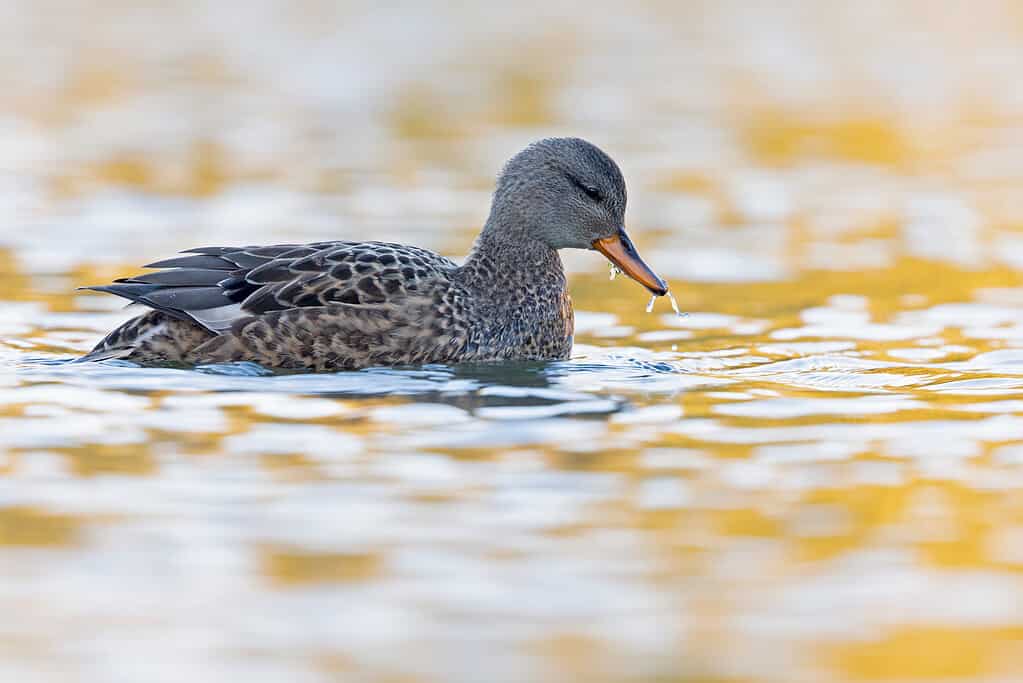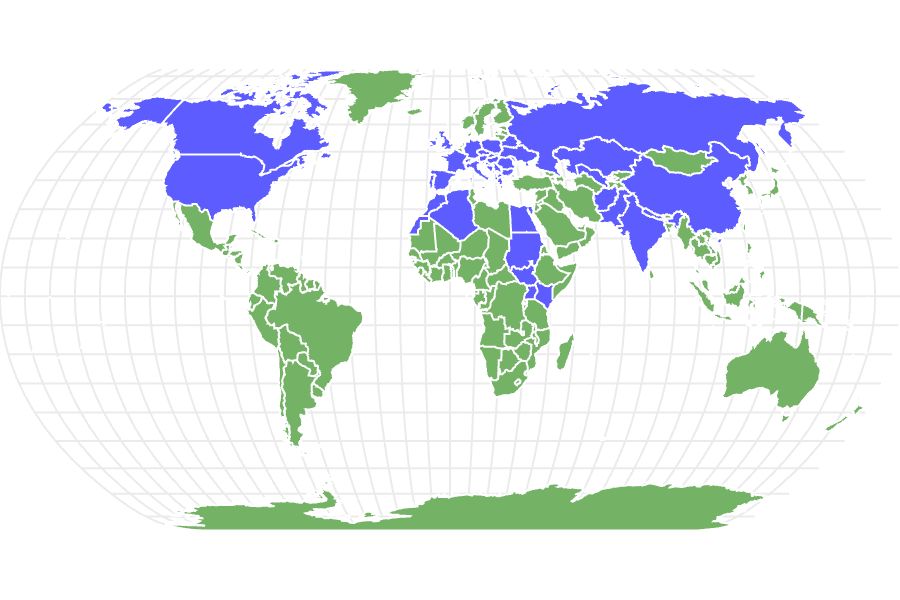Gadwall
Mareca strepera
They make many sounds when trying to attract a mate.
Advertisement
Gadwall Scientific Classification
- Kingdom
- Animalia
- Phylum
- Chordata
- Class
- Aves
- Order
- Anseriformes
- Family
- Anatidae
- Genus
- Mareca
- Scientific Name
- Mareca strepera
Read our Complete Guide to Classification of Animals.
Gadwall Conservation Status
Gadwall Facts
- Prey
- beetles, snails
- Group Behavior
- Flock
- Fun Fact
- They make many sounds when trying to attract a mate.
- Estimated Population Size
- 4.4 million
- Biggest Threat
- Predators
- Wingspan
- 33.1 inches
- Predators
- Minks, foxes, ermines, birds of prey, badgers, snakes
- Diet
- Omnivore
- Lifestyle
- Flock
- Number Of Species
- 2
- Average Clutch Size
- 9
- Nesting Location
- In the vegetation near water
- Migratory
- 1
View all of the Gadwall images!
“During courtship displays, gadwalls make a variety of different sounds to attract a mate!”
The gadwall is a common species of dabbling duck. This means that they eat their food on the surface of the water rather than diving for it. There are two subspecies, the common gadwall and the extinct Couse’s gadwall. It is a sister species to the falcated duck, which means they are closely related. Although their courtship displays can be noisy, they are typically quiet and keeps only to small flocks for much of the year.
4 Amazing Gadwall Facts
- The gadwall can be found on four different continents.
- They make a variety of sounds, including grunts, whistles, and quacks.
- They experience molts twice a year.
- They are monogamous, meaning they stay with a single mate throughout the breeding season.
Where to Find Gadwalls
Gadwalls are found both in North America and in a region known as the Palearctic. The Palearctic, also known as the Palaearctic, is a biogeographic realm, the largest of eight actually. It spans three continents: Africa, Europe, and Asia. In both North America and the Palearctic, they are most common in the middle of these regions, although they can be found as far south as Central America and Kenya.
The gadwall is considered an open wetlands bird. This means that it prefers areas like prairie lakes or steppe lakes, as well as wet grasslands and marshes with an abundance of vegetation. As a dabbling species, they are often seen floating along the water where they live. Rather than diving completely underwater like other species of ducks, they will dunk their heads underwater when foraging.
Although they prefer to live in small flocks rather than large groups, you can often see them near each other or even other species of duck.
Nests
Gadwalls are careful when planning their nests. After they form a monogamous pair, the female will scout for the perfect location while the male guards her. Typically, gadwalls will build their nests in dense, protected areas. They prefer islands where there are fewer predators, and they like to build their nests in dense bushes or shrubbery near the water.
Their nests are built on the ground. The female will create a hollow in the earth and settle into it. Then, without leaving the nest, she will use her bill to collect twigs, sticks, and leaves to create the bowl of the nest. Lastly, she will insulate the nest by plucking out her own down feathers and using them to create a lining.
Gadwall nests are small, only around one foot across and three inches deep. It takes five to seven days for the female to create an egg-ready nest.
Scientific Name
The gadwall has the scientific name Mareca strepera. The name strepera is Late Latin for “noisy, in reference to their loudness during courtship. There are two subspecies of gadwall ducks: the living common gadwall (M. s. strepera) and the extinct Coues’s gadwall (M. s. couesi).
Gadwalls are in the class of Aves, and they are a part of the family Anatidae.
Size, Appearance, & Behavior

While adult gadwalls generally reach between 19 and 23 inches, males are larger than females. A female is pictured.
©Bouke Atema/Shutterstock.com
The gadwall is an average size waterfowl. It is often compared to the mallard, both in appearance and sound. Adult gadwalls can grow to be anywhere from 19 to 23 inches in length, with males being larger than females. They weigh between 30 and 35 ounces. This species’ wingspan averages around 33.1 inches from wingtip to wingtip.
Gadwalls display sexual dimorphism. This means that males have different appearances than females. Males are grey and brown in color, with a black patch on their tails. Their bills are also black. Females, however, are typically lighter, with a brown and buff pattern. Their bills are dark as well, but they often have an orange exterior edge. Both males and females have a notable white marking on their wings that can be seen both at rest and in flight.
As far as behavior goes, gadwalls are similar to most other waterfowl. They nest on the shores and spend their days trolling along the top of the water. As dabbling ducks, they do not dive for their food. Instead, they tip their heads and bodies forward to skim food off the surface of the water. They have also been seen stealing food from other species of waterfowl, such as diving ducks and American coots.
Migration Pattern and Timing
Gadwalls will migrate in the weeks or months before they lay their eggs. Oftentimes, prior to migrating, they will have already established their mating pairs for the season.
During spring migration, gadwalls will move north in order to reach their breeding grounds. In the United States, they will migrate along the border of the United States and Canada. There is a small breeding zone in the western United States, with a majority of their breeding territory settling along the northwestern region of Canada and the southernmost coasts of Alaska.
After raising their seasonal clutch, the gadwall will migrate south again.
Diet
Gadwalls have a diet similar to many other species of ducks and geese. During the winter, their diet is mainly made up of submerged vegetation. However, during their breeding season in the warmer months of the year, other animals can make up as much as half of the gadwall’s diet.
What Do Gadwalls Eat?
Despite eating mostly submerged plants with a small amount of animal matter, gadwalls actually have a diverse diet.
For plants, they will eat the stems, roots, and seeds. The plants that make up their diet include algae, grasses, rushes, and sedges. They will also eat pondweed. As for animal matter, they eat snails, beetles, and a variety of other aquatic invertebrates.
Predators and Threats
As with many species of aquatic animals, gadwalls are threatened by human influence in the waterways. Loss of habitat and pollution can play a large role in these birds‘ detriment.
Another threat for them, both young and adult, is predators.
What Eats Gadwalls?
Humans are one of the main predators of the gadwall. Millions of individuals are harvested each year during the appropriate hunting seasons. However, humans are not the only predator. Coyotes, larger birds of prey, snakes, minks, foxes, and badgers are all examples of gadwall predators.
Gadwall Reproduction, Babies, and Lifespan
Courtship displays occur towards the end of the year. In the fall and early winter, monogamous pairs are formed. Males draw the attention of a mate by performing several different movements. These include ruffing his feathers, moving his head, and raising his tails and wings. Females will respond with their interest using similar movements. Almost all mating pairs will be formed by November.
After the mating pair has formed for the season, the two gadwalls will establish a small territory to build their nest. Gadwalls prefer secluded areas safe from as many predators as possible. Female gadwalls will only lay one clutch per year. This clutch can have anywhere from 7 to 12 eggs, each one around 2 inches in length.
It takes around 24 to 27 days for the eggs to hatch. When the young gadwalls emerge, they will be alert and covered in a complete set of down feathers. Their eyes are open, and it only takes a day or two for them to be ready to leave the nest.
After a juvenile molting, gadwalls will molt twice per year. They are ready to mate after their first year, and they can live to be over 22 years old in the wild.
Gadwall Population
The gadwall is currently listed as a species of least concern. In the decades between 1996 and 2019, it is estimated that their population increased by around 1.7%. Although they are the third most hunted duck species, their international breeding population is averaged at around 4.4 million individuals.
View all 170 animals that start with GGadwall FAQs (Frequently Asked Questions)
Do gadwalls migrate?
Gadwalls migrate each breeding season. They migrate north to lay their eggs and then return to the southern regions of their habitat afterwards.
How many eggs does the gadwall lay?
The clutch size for a gadwall varies based on the individual. They can lay anywhere from 7 to 12 eggs.
How fast do gadwalls fly?
The United States Geological Survey has found that the migratory flight speed of gadwalls is about 44 miles an hour.
What is the gadwall's wingspan?
Gadwalls have a wingspan of around 33.1 inches.
When do gadwalls leave the nest?
Gadwalls are able to leave the nest one to two days after hatching.
Thank you for reading! Have some feedback for us? Contact the AZ Animals editorial team.
Sources
- https://www.pwrc.usgs.gov/bbs/about/ (2007) 03/10/2023
- North American Breeding Bird Survey (1970) 03/10/2023

















